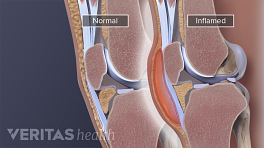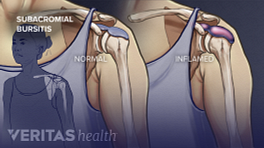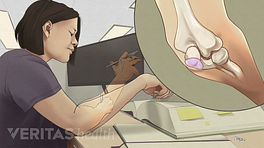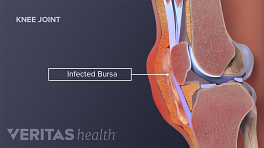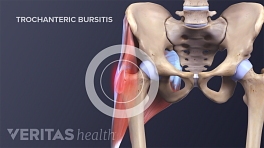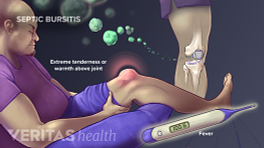Bursae are small, slippery sacs of fluid that provide cushion and reduce friction for joint tissues, such as tendons. The body contains about 140 bursae, 1 Azar FM, Beaty JH, Canale TS, eds. Campbell’s Operative Othopaedics, 13th ed., vol 1, page 482. Philadelphia PA: Elsevier; 2017. and when one becomes inflamed it is called bursitis. A few bursae are especially prone to bursitis, a condition that can cause swelling, pain, and stiffness at a joint.
Elbow (olecranon) bursitis is one of the most common types of bursitis.
This page describes which joints are most likely to be affected by bursitis and the specific bursae that may become inflamed.
See What Is a Bursa?
Knee Bursitis
There are several bursae in the knee, and a few of them are particularly susceptible to bursitis. Knee bursitis symptoms vary depending on which bursa is affected.
Prepatellar bursitis
A lime- or grapefruit-sized lump in front of the kneecap—just beneath the skin—may be a sign of prepatellar bursitis. When pressed, the lump may feel like a water balloon. The knee may also be tender, stiff, and painful.
When healthy, a prepatellar bursa reduces friction between the kneecap and skin. Frequent kneeling can irritate the prepatellar bursa and is often the cause of this type of bursitis. In addition, the prepatellar bursa is prone to septic bursitis, 2 Lormeau C, Cormier G, Sigaux J, Arvieux C, Semerano L. Management of septic bursitis. Joint Bone Spine. 2019 Oct;86(5):583-588. doi: 10.1016/j.jbspin.2018.10.006. Epub 2018 Oct 26. PMID: 31615686. which requires urgent medical care.
See Knee (Prepatellar) Bursitis
Pes anserine bursitis
Symptoms of pes anserine bursitis typically include pain and swelling on the inside (medial side) of the knee, 2 or 3 inches below the knee joint. A healthy pes anserine bursa reduces friction between the shin’s tibia bone and the tendons of the hamstring muscles.
There are many possible causes of pes anserine bursitis, including tight hamstrings.
Iliotibial bursitis
Symptoms of iliotibial bursitis include pain and swelling at the outside (lateral side) of the knee. A healthy iliotibial bursa reduces friction between the shin’s tibia bone and the iliotibial band (IT band), a thick, fibrous tissue that extends from the outer hip to just below the knee.
Iliotibial bursitis is associated with a tight IT band. 3 Chatra PS. Bursae around the knee joints. Indian J Radiol Imaging. 2012;22(1):27-30. doi:10.4103/0971-3026.95400
Elbow Bursitis
Swelling at the tip of the elbow is the hallmark sign of bursitis in the olecranon bursa. This condition may also cause pain, tenderness, and joint stiffness.
The olecranon bursa reduces friction between the skin and the end of the forearm’s ulna bone, called the olecranon. Elbow bursitis is typically caused by repeatedly resting weight on the elbow. It has earned nicknames such as student’s elbow and miner’s elbow.
Like the prepatellar bursa in the knee, the olecranon bursa is prone to septic bursitis, 2 Lormeau C, Cormier G, Sigaux J, Arvieux C, Semerano L. Management of septic bursitis. Joint Bone Spine. 2019 Oct;86(5):583-588. doi: 10.1016/j.jbspin.2018.10.006. Epub 2018 Oct 26. PMID: 31615686. which is caused by an infection and requires immediate medical care.
See Elbow (Olecranon) Bursitis
Heel Bursitis
Swelling at the back of the heel or ankle can be a sign of bursitis. Two types of bursitis can affect the heel:
Retrocalcaneal bursitis
This type of bursitis is often associated with moderate- to high-impact activity. It may also be related to a foot or ankle problem, such as Achilles tendonitis or an abnormal bony growth at the back of the heel called a Haglund deformity. The retrocalcaneal bursa is located in between the heel bone and the Achilles tendon.
Subcutaneous calcaneal bursitis
A hard, red bump at the back of the heel may be a sign of bursitis in the subcutaneous calcaneal bursa. This bursa is located in between the Achilles tendon and the skin at the back of the heel. It often becomes inflamed when poorly-fitting shoes dig into the back of the heel.
See Heel (Retrocalcaneal and Calcaneal) Bursitis
Shoulder Bursitis
Shoulder bursitis is closely associated with a condition called shoulder impingement syndrome. The shoulder’s bursa, along with tendons and other soft tissue, is sandwiched in between the shoulder’s ball-and-socket joint and another bone called the acromion. (The acromion is an extension of the scapula bone). The bursa may become pinched when raising the arm.
While shoulder bursitis has many potential causes, it is often associated with people who engage in repeated overhead motion, such as swimmers, baseball pitchers, carpenters, and painters. Side-sleeping on the affected shoulder puts extra pressure on the bursa and may trigger pain.
Hip Bursitis
Two bursae in the hip are especially prone to hip bursitis: the trochanteric bursa and the iliopsoas bursa. Both conditions may be referred to as hip bursitis and involve similar steps for diagnosis and treatment.
Trochanteric bursitis
Pain and tenderness where the upper thigh curves outward can be a sign of trochanteric bursitis. This type of hip bursitis is often associated with a condition called greater trochanter pain syndrome.
The greater trochanter is the bony knob near the top of the thigh bone (femur). The trochanteric bursa is located over this bony knob. It provides a cushion and reduces friction between the bone’s surface and the soft tissue (Iliotibial band) that runs over it during hip and knee movement. This type of hip bursitis may be associated with spending a lot of time sitting, a tight iliotibial band, weak gluteal muscles, or a fall or other impact injury to the hip.
Read more about IT Band Syndrome Causes and Risk Factors on Sports-health.com.
Iliopsoas bursitis
Pain at the front of the hip and/or groin area may be a sign of iliopsoas bursitis. The iliopsoas bursa is located near the groin, under the iliopsoas muscle. While this type of bursitis can affect anyone, it tends to develop in athletes and other people who work out regularly or have tight hip muscles.
See Hip (Trochanteric) Bursitis
Bursitis in any joint can become chronic if it is left untreated. A doctor can accurately diagnose bursitis and recommend treatments and preventative strategies.
Learn more
- 1 Azar FM, Beaty JH, Canale TS, eds. Campbell’s Operative Othopaedics, 13th ed., vol 1, page 482. Philadelphia PA: Elsevier; 2017.
- 2 Lormeau C, Cormier G, Sigaux J, Arvieux C, Semerano L. Management of septic bursitis. Joint Bone Spine. 2019 Oct;86(5):583-588. doi: 10.1016/j.jbspin.2018.10.006. Epub 2018 Oct 26. PMID: 31615686.
- 3 Chatra PS. Bursae around the knee joints. Indian J Radiol Imaging. 2012;22(1):27-30. doi:10.4103/0971-3026.95400

